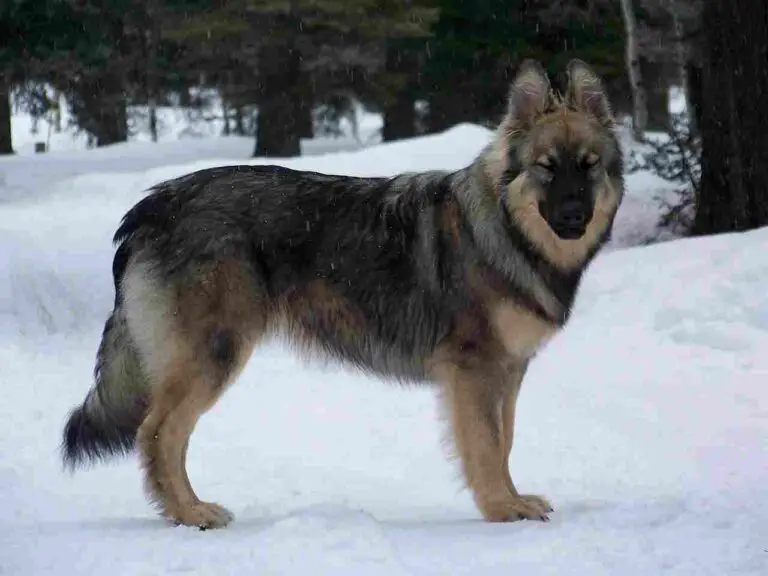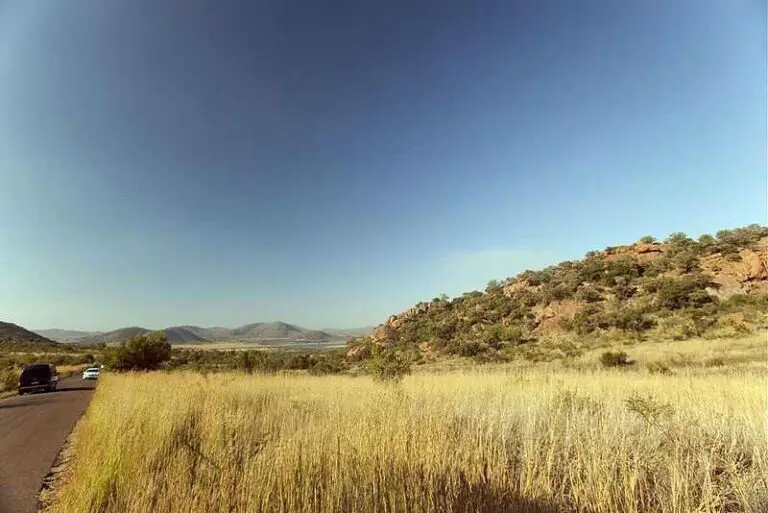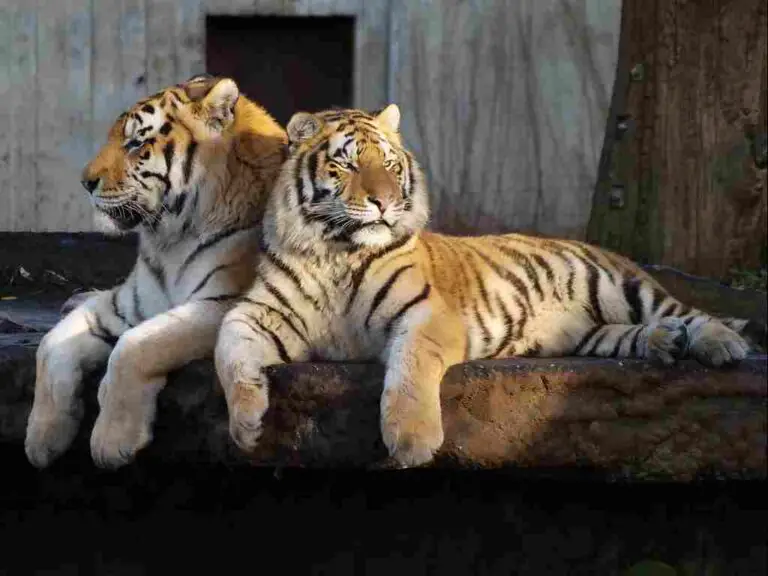Grizzly Bear Vs Lion Size, Weight, Behavior Comparison
Grizzly bears and lions are two formidable predators that can be compared to each other based on factors like size, weight, behavior, and ecological characteristics. By examining these aspects, we can gain insights into their similarities and differences, as well as predict the outcomes of potential interactions between them.
In this article, we will delve into the physical and behavioral comparisons between grizzly bears and lions, shedding light on their unique traits and highlighting the potential implications of their coexistence in the wild.
Key Outcomes of Comparison
A) Size:
When comparing the size of grizzly bears and lions, it is evident that grizzly bears are larger. Adult male grizzly bears can reach a height of 7 feet and weigh up to 1,500 pounds, while male lions typically measure around 4 feet at the shoulder and weigh around 420 pounds.
B) Weight:
Grizzly bears also outweigh lions significantly. The average weight of a male grizzly bear is more than three times that of a male lion.
C) Taxonomic Classification:
Grizzly bears belong to the Ursidae family, while lions are part of the Felidae family.
D) Hypothetical Interaction:
In a hypothetical confrontation between a grizzly bear and a lion, the grizzly bear would likely emerge as the victor. Due to its larger size, greater strength, and powerful bite force, the grizzly bear has the advantage in such a scenario.
*Physical Comparison
1). Size
The size of a grizzly bear and a lion can be compared based on their average height and total body length. Grizzly bears are known for their large size, with adult males reaching an average height of 3 to 3.5 feet at the shoulder and a total body length of 6 to 7 feet. On the other hand, lions are slightly smaller in terms of height, with adult males standing at an average height of 3.5 to 4 feet at the shoulder and a total body length of 6 to 8 feet.
When comparing the size of a grizzly bear and a lion, it is important to note that both species can vary in size depending on factors such as age, sex, and geographical location. However, in general, grizzly bears tend to be larger and heavier than lions.
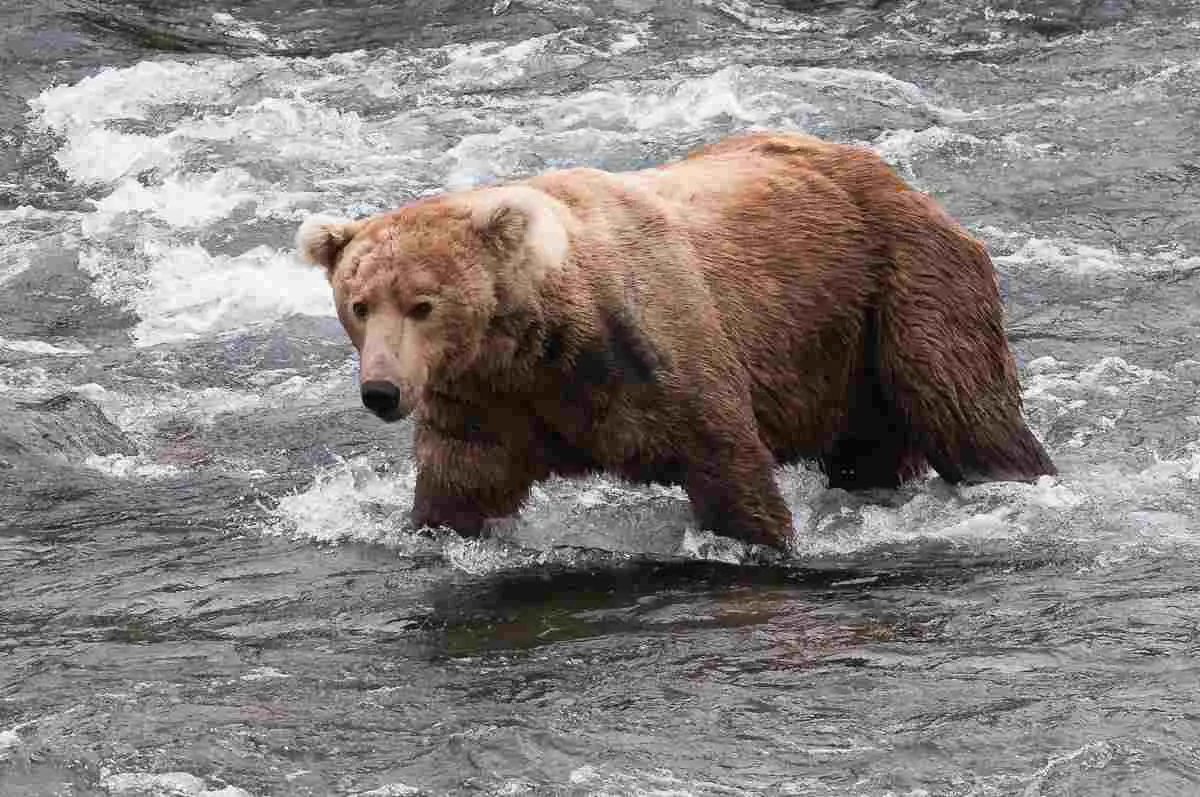
2). Weight
When comparing the weight of a grizzly bear and a lion, it is important to consider the average weight of both males and females. On average, adult male grizzly bears can weigh between 400 to 790 pounds, while adult females typically weigh between 290 to 440 pounds. In contrast, adult male lions have an average weight ranging from 330 to 550 pounds, while adult females weigh around 265 to 395 pounds.
In terms of which species is heavier, grizzly bears generally have a higher average weight compared to lions. This can be attributed to the fact that grizzly bears are larger in size overall, with a more robust build and a higher muscle mass. Lions, although powerful predators in their own right, have a more slender and agile physique.
The weight of both grizzly bears and lions can vary depending on factors such as age, sex, and availability of food sources. Additionally, it is worth noting that individual variations within each species can also contribute to differences in weight.
3). Skeletal Anatomy
The skeletal anatomy of a grizzly bear and a lion reveals significant differences in their bone structure and density. Grizzly bears have a robust skeletal structure, with strong bones that are adapted to support their massive size and weight. Their bones are dense and thick, providing them with the strength and stability needed for their powerful movements and activities. Lions, on the other hand, have a more slender skeletal structure, with lighter and less dense bones. This allows them to be more agile and swift in their movements, making them highly efficient hunters.
The differences in skeletal anatomy between grizzly bears and lions are a reflection of their distinct evolutionary adaptations and ecological roles. Grizzly bears rely on their strong bones to support their large bodies and powerful movements, enabling them to dig, climb, and engage in other physically demanding activities. Lions, on the other hand, prioritize speed and agility, which is facilitated by their lighter skeletal structure.
Understanding the skeletal anatomy of these two apex predators provides valuable insights into their physical capabilities and adaptations. It highlights how their bone structure is intricately linked to their size, weight, and mode of locomotion.
4). Mode of Locomotion
The mode of locomotion of a grizzly bear and a lion differs significantly due to their distinct physical characteristics and adaptations. Grizzly bears are powerful runners, capable of reaching speeds of up to 35 miles per hour. Their muscular limbs and strong build allow them to cover long distances on land, making them efficient hunters and foragers. In contrast, lions are renowned for their agility and leaping ability. They can leap distances of up to 36 feet and reach speeds of around 50 miles per hour in short bursts. This agility enables them to ambush and capture their prey with precision.
While both grizzly bears and lions are adept climbers, their climbing techniques vary. Grizzly bears have strong claws and muscular forelimbs, allowing them to climb trees with relative ease. They often climb trees to escape danger or to access food sources such as berries or beehives. Lions, on the other hand, are not as proficient climbers. Their body structure is better suited for ground-based hunting, and they rely on their speed and stealth rather than climbing abilities.
In terms of swimming, grizzly bears are excellent swimmers and can swim long distances. They use their powerful limbs and buoyant bodies to navigate through water, making them capable of crossing rivers and lakes. Lions, however, are not known for their swimming abilities and tend to avoid water whenever possible.
The contrasting modes of locomotion between grizzly bears and lions reflect their different ecological roles and hunting strategies. Grizzly bears rely on their strength and endurance to pursue and capture prey on land, while lions utilize their agility and speed for successful ambushes.
5). Speed
The speed of both grizzly bears and lions is impressive, but there are some differences between the two.
Grizzly bears have an average running speed of about 30 miles per hour, allowing them to cover long distances on land. This speed is crucial for their hunting and foraging activities. On the other hand, lions are known for their bursts of speed, reaching up to 50 miles per hour in short sprints. This acceleration enables them to quickly close the gap between themselves and their prey during an ambush.
When it comes to agility, lions have the advantage. Their ability to change direction quickly and make sharp turns while running gives them an edge in pursuing and capturing prey. Grizzly bears, although powerful runners, are not as agile as lions due to their larger size and build.
In terms of endurance, grizzly bears have the upper hand. They can maintain their speed for longer periods, allowing them to chase down prey over long distances. Lions, while faster in short bursts, tire more quickly and rely on their ambush tactics to make successful kills.
6). Agility
When comparing the agility of grizzly bears and lions, we need to consider their speed and mode of locomotion. Both animals exhibit impressive agility, but there are some notable differences.
In terms of speed, lions have the advantage. With their bursts of speed reaching up to 50 miles per hour, they can quickly close the gap between themselves and their prey during an ambush. This acceleration allows them to make sharp turns and change direction swiftly, giving them an edge in pursuing and capturing prey.
On the other hand, grizzly bears, although powerful runners, are not as agile as lions due to their larger size and build. Their average running speed of about 30 miles per hour is still impressive, but they lack the ability to make quick turns and change direction as swiftly as lions.
When it comes to mode of locomotion, lions are primarily quadrupeds, using all four limbs for movement. This quadrupedal stance provides them with stability and agility, especially during high-speed pursuits. Grizzly bears, on the other hand, are also quadrupeds but can occasionally adopt a bipedal stance, standing on their hind legs. While this allows them to have a better view of their surroundings, it limits their agility compared to lions.
7). Relative Strength and Endurance
When comparing the relative strength and endurance of grizzly bears and lions, several factors need to be considered, including muscular endurance, size, weight, and agility.
In terms of muscular endurance, grizzly bears have the advantage. Their powerful build and muscular physique allow them to sustain physical exertion for extended periods. This endurance is crucial for activities such as hunting, foraging, and defending their territory. Lions, although strong predators, do not possess the same level of muscular endurance as grizzly bears.
Size and weight also play a significant role in determining relative strength. Grizzly bears are generally larger and heavier than lions, giving them an inherent advantage in terms of sheer strength. Their robust frame and powerful limbs enable them to overpower prey and exert force when necessary. Lions, while formidable predators, are comparatively smaller and lighter, which affects their overall strength in comparison to grizzly bears.
Agility, however, is an area where lions excel. Their speed and ability to make quick turns and change direction swiftly contribute to their hunting prowess. While grizzly bears are powerful runners, their larger size and build limit their agility in comparison to lions.
8). Bite force
When comparing the bite force of grizzly bears and lions, it is important to consider their average bite force and determine which animal has a higher bite force. The bite force of an animal is a crucial factor in its hunting and feeding habits, as well as its ability to defend itself against potential threats.
Grizzly bears are known for their impressive bite force. With their strong jaws and sharp teeth, they can exert a significant amount of pressure when biting down. This bite force allows them to effectively capture and kill their prey, which often includes large mammals such as elk and moose. The powerful bite of a grizzly bear is a testament to its strength and predatory abilities.
On the other hand, lions also possess a formidable bite force. While not as powerful as that of a grizzly bear, a lion’s bite force is still considerable. Lions primarily use their strong jaws and sharp teeth to bring down their prey, which typically consists of ungulates such as zebras and wildebeests. The bite force of a lion is an essential tool in its hunting strategy and plays a crucial role in its ability to survive in the wild.
9). Attack and Defense Method(s)
When comparing the attack and defense methods of grizzly bears and lions, it is important to consider the weapons and strategies they employ in order to survive and protect themselves in their respective habitats.
Grizzly bears primarily rely on their physical strength and powerful forelimbs as their main form of attack and defense. With their sharp claws, they can inflict deep wounds on their opponents, making them formidable adversaries. Additionally, grizzly bears have been known to use their sheer size and weight to intimidate and overpower potential threats. This combination of strength, claws, and size makes them highly efficient in both attacking and defending themselves.
On the other hand, lions utilize a different set of attack and defense methods. Their most prominent weapon is their sharp teeth and strong jaws, which they use to deliver lethal bites to their prey or adversaries. Lions also possess a unique social structure that allows them to work together in coordinated attacks, making them highly efficient hunters. When it comes to defense, lions rely on their speed and agility to evade threats, as well as their intimidating roars to ward off potential attackers.
*Hypothetical Interaction
In a hypothetical encounter between a grizzly bear and a lion, the outcome of a fight would likely favor the grizzly bear. This prediction is based on a comparison of their physical attributes, such as size, strength, and weaponry.
The grizzly bear’s immense size and weight give it a significant advantage over the lion. With its powerful forelimbs and sharp claws, the grizzly bear can inflict deep wounds on its opponent. Additionally, the grizzly bear’s sheer strength and intimidating presence make it a formidable adversary.
On the other hand, the lion relies on its sharp teeth and strong jaws as its primary weapons. While the lion’s speed and agility are impressive, they may not be enough to overcome the sheer power and size of the grizzly bear.
*Behavioral Comparison
10). Feeding/Predation Habits
Feeding habits play a crucial role in understanding the behavior and survival strategies of animals. Both the grizzly bear and the lion have distinct feeding habits that contribute to their respective ecological roles.
The grizzly bear is an omnivore, meaning it consumes both plant and animal matter. Its diet consists of a wide range of food sources, including berries, nuts, grasses, fish, small mammals, and carrion. This versatility allows the grizzly bear to adapt to different environments and seasons, ensuring its survival in various habitats. When it comes to predation, the grizzly bear primarily relies on its powerful paws and sharp claws to catch and kill prey.
On the other hand, the lion is a carnivore, specializing in hunting and consuming meat. Its diet mainly consists of large ungulates such as zebras, wildebeests, and buffalo. Lions are highly skilled predators that rely on their strength, speed, and cooperative hunting strategies to bring down their prey. They often use a combination of stealth, teamwork, and strategic positioning to increase their chances of a successful hunt.
While both the grizzly bear and the lion are formidable predators in their own right, their feeding habits and modes of predation differ due to their distinct ecological niches. The grizzly bear’s omnivorous diet allows it to be more adaptable and opportunistic in its feeding habits, while the lion’s specialization as a carnivore makes it a highly efficient predator in the African savannah.
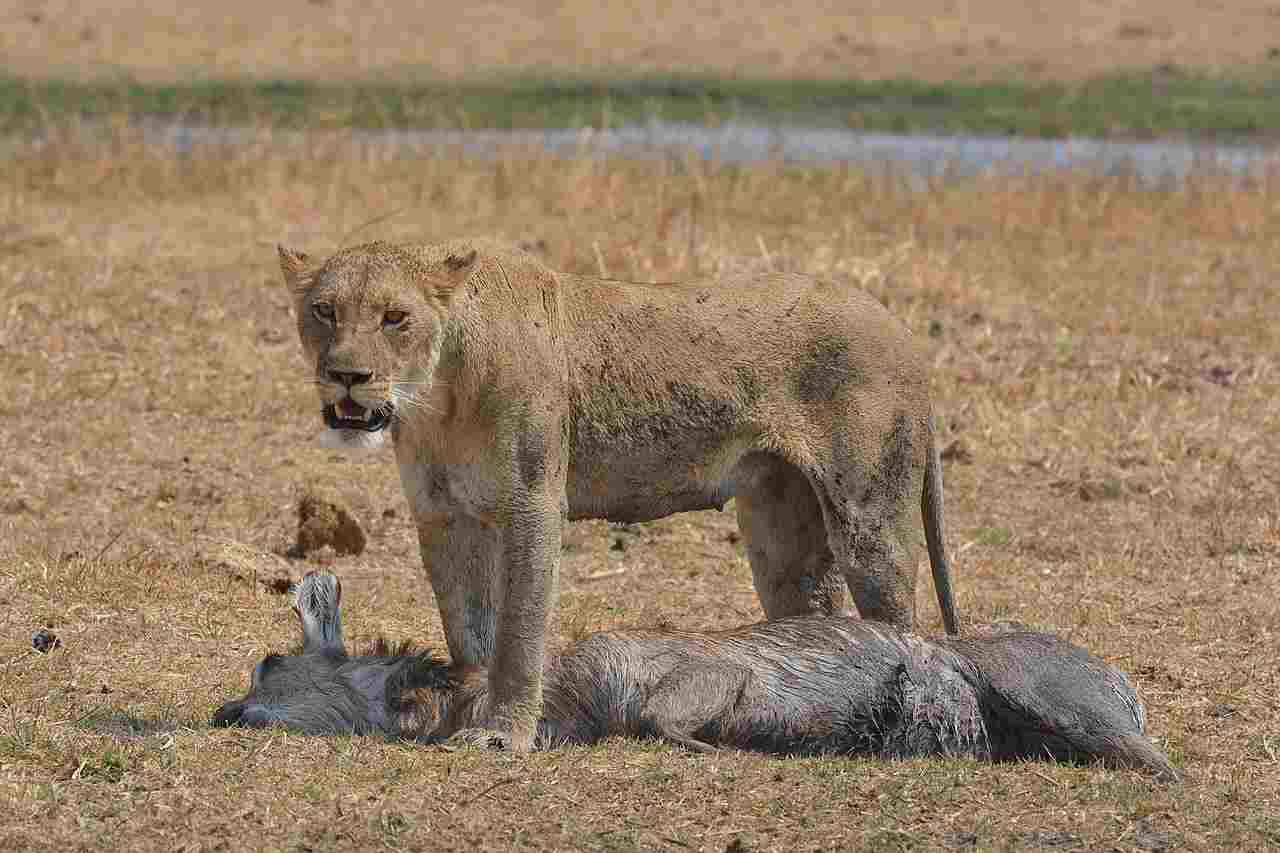
11). Social Behavior
The social behavior of animals can vary greatly, with some species being solitary while others are highly social. Both the grizzly bear and the lion exhibit distinct social behaviors that contribute to their survival and reproductive success.
Grizzly bears are generally solitary animals, with adult males and females typically living and foraging alone. However, they do exhibit social behavior during the mating season and when raising their young. Female grizzly bears are known for their strong maternal instincts and will fiercely protect their cubs. Cubs stay with their mother for about two to three years, during which time they learn essential survival skills.
In contrast, lions are highly social animals, living in groups known as prides. A pride typically consists of several related adult females, their offspring, and a few adult males. Lions within a pride engage in cooperative hunting, with females working together to bring down large prey. Social bonds within the pride are strong, and members engage in grooming, playing, and resting together. The presence of multiple males in a pride helps protect the group from outside threats and increases the chances of successful reproduction.
While both the grizzly bear and the lion exhibit social behavior, their social structures and interactions differ significantly. The grizzly bear’s social behavior is centered around maternal care and the rearing of offspring, while the lion’s social behavior revolves around the formation and maintenance of prides for hunting and protection.
12). Aggressive Tendency
The aggressive tendencies of animals can vary depending on various factors such as territoriality, competition for resources, and mating behavior. Both the grizzly bear and the lion are known for their potential aggression, although they exhibit it in different ways.
Grizzly bears are generally not aggressive towards humans unless they feel threatened or provoked. However, they can display aggressive behavior when defending their cubs or territory. The presence of food scarcity or competition can also trigger aggression in grizzly bears. It is important to exercise caution and respect their space when encountering them in the wild.
On the other hand, lions are known for their aggressive nature, especially during territorial disputes and when protecting their pride. Male lions can be particularly aggressive towards intruders, including other male lions, in order to establish dominance and protect their territory. They may also exhibit aggression during mating, as competition for mates can be intense.
13). Danger to Humans (and Pets)
When considering the danger posed by grizzly bears and lions to humans and pets, it is important to understand their behavior and potential for aggression. Both animals have the capability to harm, and in rare cases, even kill humans or pets. However, it is crucial to note that such incidents are relatively uncommon and usually occur when there is a direct threat or provocation.
Grizzly bears, although known for their strength and ferocity, are generally not aggressive towards humans unless they feel threatened or provoked. They are more likely to display defensive behavior when protecting their cubs or territory. Instances of grizzly bears attacking humans or pets are rare, but they can occur if the bear feels its safety is compromised.
On the other hand, lions are known for their aggressive nature, especially when it comes to protecting their pride or during territorial disputes. While attacks on humans are relatively rare, they can happen in certain circumstances, such as encounters in the wild or when lions feel threatened. However, it is important to note that lions primarily prey on wild animals and do not typically view humans as prey.
13a). Likelihood of Interaction (With Humans)
Grizzly bears and lions have different likelihoods of interaction with humans due to their habitats and behavior. Grizzly bears are more commonly found around human settlements, especially in areas where their natural habitat has been encroached upon. This can increase the chances of encounters between humans and grizzly bears. On the other hand, lions are typically found in more remote areas, such as savannas and grasslands, away from human settlements. Therefore, the likelihood of direct interaction between lions and humans is generally lower compared to grizzly bears.
However, it is important to note that both grizzly bears and lions are wild animals and should be treated with caution. Encounters with either species can be dangerous, and it is crucial to follow precautionary measures to minimize the risk of harm. These measures include avoiding close proximity to the animals, not approaching or feeding them, and being aware of their presence when in their natural habitats.
13b). Precautionary Measure(s)
When encountering a grizzly bear or a lion, it is crucial to take precautionary measures to ensure your safety. Firstly, it is important to remain calm and avoid any sudden movements that may provoke the animal. Secondly, maintain a safe distance and do not approach or attempt to feed the animal. Remember, both grizzly bears and lions are wild animals and should be respected as such.
If you encounter a grizzly bear, it is recommended to slowly back away while facing the bear and speaking calmly. In the case of a lion encounter, it is advised to stand your ground, make yourself appear larger, and make loud noises to deter the lion. Always be aware of your surroundings and follow any local guidelines or regulations regarding wildlife encounters.
*Ecological Comparison
14). Taxonomic Classification
The taxonomic classification of the grizzly bear and lion reveals interesting insights into their evolutionary relationships. The grizzly bear, scientifically known as Ursus arctos horribilis, belongs to the genus Ursus and the species arctos. On the other hand, the lion, scientifically known as Panthera leo, belongs to the genus Panthera and the species leo. Despite their distinct classifications, both species are part of the same family, Ursidae, which includes bears, and the subfamily Pantherinae, which includes big cats.
This taxonomic relationship implies a distant evolutionary connection between the grizzly bear and lion. While they share a common ancestor, their physical characteristics and behaviors have diverged over time due to different environmental pressures and adaptations. The grizzly bear has evolved to thrive in forested habitats, while the lion has adapted to life on the African savannah.
15). Skin/Coat Texture, Camouflage
The skin and coat texture, color, and camouflage of the grizzly bear and lion are distinct and adapted to their respective habitats and lifestyles.
The grizzly bear has a thick, shaggy coat that provides insulation and protection in its cold, forested environment. The fur is usually brown, but it can vary in color from light blonde to dark brown. This variation in coloration helps the grizzly bear blend into its surroundings, making it difficult for prey or predators to spot it. The texture of the grizzly bear’s fur is coarse and wiry, providing additional protection against the elements and potential threats.
In contrast, the lion has a short, smooth coat that is typically a tawny color. The coloration of the lion’s coat helps it blend into the golden grasses of the African savannah, providing camouflage during hunting and stalking. The lion’s fur is not as thick as the grizzly bear’s, but it still provides some protection against the sun and minor injuries.
Both the grizzly bear and lion have adapted their skin and coat characteristics to suit their respective environments and hunting strategies. While the grizzly bear relies on its thick, shaggy coat for insulation and protection in colder climates, the lion’s short, smooth coat helps it blend into the grasslands of the savannah. These adaptations are essential for their survival and success in their respective habitats.
16). Reproduction
Both the grizzly bear and lion are viviparous, meaning they give birth to live young rather than laying eggs. However, there are some differences in their reproductive processes.
The gestation period of a grizzly bear is approximately 6 to 8 months. Female grizzly bears typically mate in the spring and give birth to one to four cubs in the den during the winter months. The cubs are born blind and helpless, relying on their mother for nourishment and protection. The female grizzly bear is solely responsible for raising and caring for her cubs until they are old enough to venture out on their own.
In contrast, the gestation period of a lion is around 100 to 110 days. Female lions can mate throughout the year, and the cubs are usually born in a secluded den. Lion cubs are also born blind and rely on their mother for survival. However, lionesses in a pride often cooperate in raising the cubs, sharing nursing and protective duties. This cooperative behavior helps to ensure the survival and development of the lion cubs.
Overall, while both the grizzly bear and lion have viviparous reproduction, the grizzly bear has a longer gestation period and the female is solely responsible for raising the cubs. On the other hand, lionesses in a pride work together to care for and protect the cubs, enhancing their chances of survival.
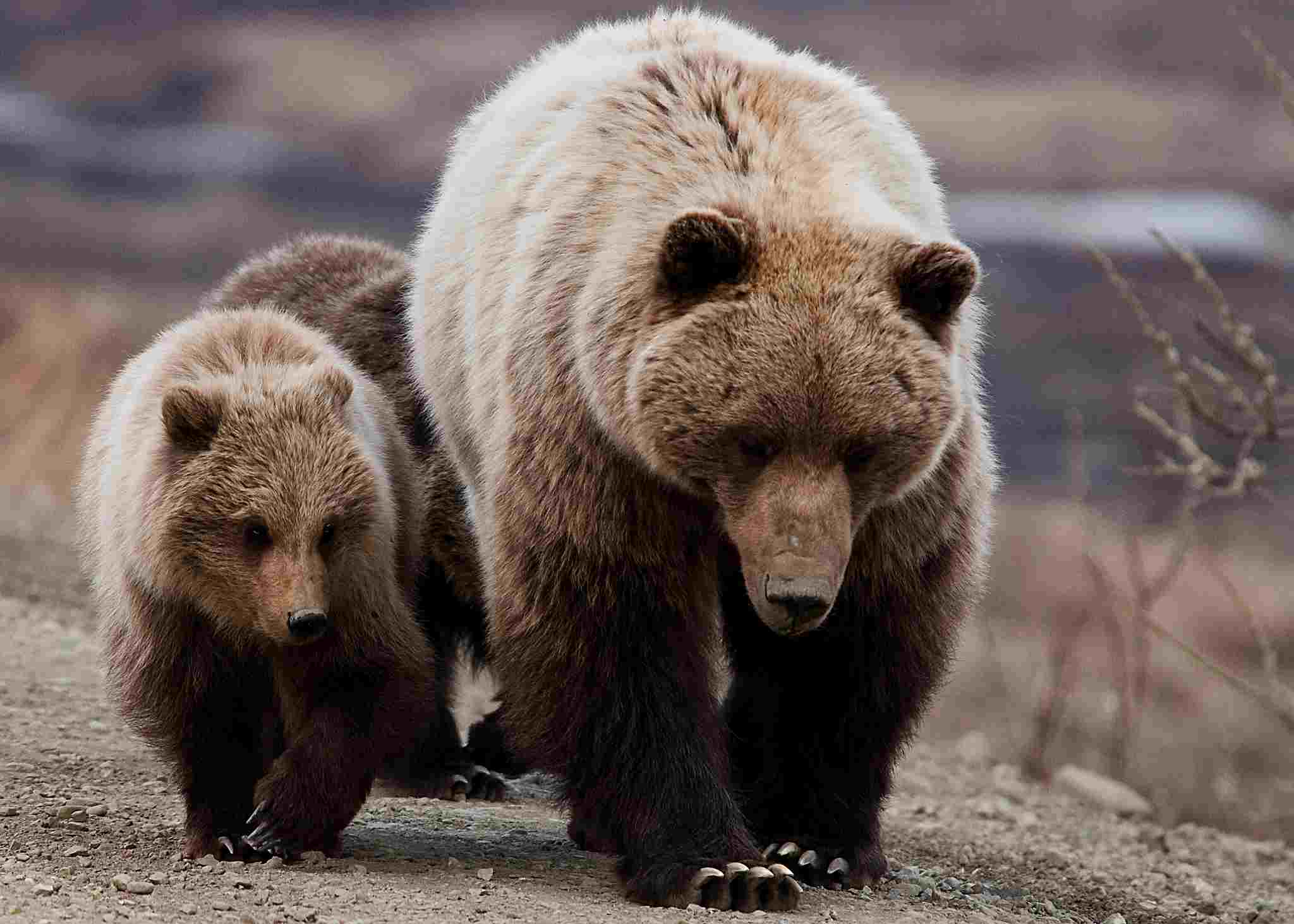
17). Lifespan
The lifespan of grizzly bears and lions can vary depending on various factors such as their habitat, availability of food, and exposure to threats. In the wild, grizzly bears have an average lifespan of around 20 to 25 years. However, some grizzly bears have been known to live up to 30 years or more. On the other hand, lions in the wild have a slightly shorter lifespan, with an average of 10 to 14 years.
In captivity, both grizzly bears and lions tend to have longer lifespans compared to their wild counterparts. Grizzly bears in captivity can live up to 35 years or more, while lions can live up to 20 years or more. The controlled environment, regular veterinary care, and consistent food supply contribute to their extended lifespans in captivity.
When comparing the lifespan of grizzly bears and lions, it is evident that grizzly bears generally have a longer lifespan in both the wild and captivity. This can be attributed to their relatively lower exposure to human-induced threats and their ability to adapt to a wider range of habitats. Lions, on the other hand, face various challenges such as habitat loss, poaching, and conflicts with humans, which can significantly impact their lifespan.
18). Habitat
Grizzly bears and lions have distinct habitats that reflect their different ecological needs and preferences. Grizzly bears are primarily found in North America, inhabiting a range of ecosystems including forests, mountains, and tundra regions. They are adaptable creatures, capable of thriving in diverse habitats such as coastal areas, alpine meadows, and even arid grasslands. This versatility allows grizzly bears to occupy a larger geographic range compared to lions.
On the other hand, lions are predominantly found in Africa, with a smaller population in the Gir Forest of India. They are well-suited to the grassy plains and savannahs of Africa, where they can camouflage themselves and stalk their prey effectively. Lions are social animals, forming prides that require vast territories to roam and hunt. Their habitat preference is influenced by the availability of prey species and the need for open spaces to facilitate their hunting strategies.
While both grizzly bears and lions have adapted to specific habitats, the geographic range of grizzly bears is more extensive due to their ability to inhabit a wider variety of ecosystems. This adaptability allows grizzly bears to thrive in different environments, from dense forests to high-altitude mountain ranges. In contrast, lions are more restricted to the grasslands and savannahs of Africa, where they have evolved to excel in their hunting techniques and social structures.
19). Geographic Range
The geographic range of grizzly bears and lions differs significantly due to their distinct habitats and evolutionary adaptations. Grizzly bears are primarily found in North America, inhabiting a wide range of ecosystems including forests, mountains, and tundra regions. Their adaptability allows them to thrive in diverse habitats such as coastal areas, alpine meadows, and even arid grasslands. This extensive geographic range increases the chances of grizzly bears crossing paths with various species in nature.
On the other hand, lions are predominantly found in Africa, with a smaller population in the Gir Forest of India. They are well-suited to the grassy plains and savannahs of Africa, where they can camouflage themselves and stalk their prey effectively. Due to their specific habitat preferences, the geographic range of lions is more limited compared to grizzly bears. However, within their range, lions have evolved to coexist with other African wildlife, forming complex ecosystems and intricate predator-prey relationships.
While grizzly bears and lions may share certain regions, such as the grasslands of Africa, their overall geographic ranges are distinct. Grizzly bears have a broader distribution, spanning across North America, while lions are more restricted to specific regions in Africa. These differences in geographic range reflect the unique ecological needs and adaptations of each species, shaping their interactions with other organisms and their overall ecological importance.
20). Ecologic Importance
The ecological importance of grizzly bears and lions lies in their unique roles and functions within their respective ecosystems. Grizzly bears play a crucial role as keystone species, influencing the structure and dynamics of their habitats.
As omnivores, they have a diverse diet that includes berries, nuts, fish, and small mammals. By foraging on vegetation and dispersing seeds through their scat, grizzly bears contribute to the regeneration and diversity of plant communities. They also act as predators, controlling populations of herbivores and scavenging carrion, which helps maintain a healthy balance in the ecosystem.
Similarly, lions have a significant ecological impact as apex predators in African grasslands and savannahs. Their presence helps regulate herbivore populations, preventing overgrazing and promoting the health of vegetation. Lions also scavenge on carcasses, reducing the spread of diseases and recycling nutrients back into the ecosystem. Furthermore, their hunting behavior shapes the behavior and distribution of prey species, leading to a cascade of effects on the entire food web.
Both grizzly bears and lions contribute to the ecological balance of their habitats through their feeding habits, predation, and scavenging behaviors. Their presence influences the abundance and distribution of other species, creating a complex web of interactions and dependencies.
21). Conservation Status
The conservation status of grizzly bears and lions is a matter of concern due to their threatened or endangered status. Both species face significant challenges that impact their populations and habitats.
Grizzly bears are listed as a threatened species in the United States, with their numbers declining due to habitat loss, fragmentation, and human-wildlife conflicts. The destruction of their natural habitats, such as forests and meadows, has resulted in a reduction in their range and available food sources.
Additionally, conflicts with humans, including poaching and vehicle collisions, pose a threat to their survival. Conservation efforts focus on protecting and restoring their habitats, implementing measures to reduce conflicts, and promoting public awareness and education.
Similarly, lions are also facing a decline in their populations and are listed as vulnerable by the International Union for Conservation of Nature (IUCN). Habitat loss, human-wildlife conflicts, and illegal hunting are the main threats to their survival. The conversion of grasslands into agricultural land and the expansion of human settlements have led to a decrease in their natural habitat and prey availability. Conservation initiatives aim to protect lion populations, establish protected areas, and promote sustainable land-use practices.
Efforts to conserve grizzly bears and lions involve a combination of habitat preservation, wildlife management, and community engagement. By addressing the underlying causes of their decline and implementing conservation strategies, we can work towards ensuring the long-term survival of these species.
22). Main Threats to Survival
The main threats to the survival of both grizzly bears and lions are human-induced factors and habitat loss. Human activities such as deforestation, urbanization, and agricultural expansion have resulted in the destruction and fragmentation of their natural habitats. This loss of habitat directly impacts their ability to find food, establish territories, and reproduce.
For grizzly bears, the destruction of forests and meadows has led to a reduction in their range and available food sources. This, coupled with human-wildlife conflicts, including poaching and vehicle collisions, poses a significant threat to their survival. The illegal killing of grizzly bears for their body parts and the encroachment of human settlements into their territories further exacerbate their vulnerability.
Similarly, lions face similar challenges due to habitat loss and human-wildlife conflicts. The conversion of grasslands into agricultural land and the expansion of human settlements have resulted in a decrease in their natural habitat and prey availability. Additionally, illegal hunting and retaliatory killings by humans pose a significant threat to lion populations.
Conservation efforts for both species focus on addressing these main threats to survival. This includes implementing measures to protect and restore their habitats, reducing conflicts with humans through education and awareness programs, and enforcing strict anti-poaching laws.
Conclusion
-Similarities
When comparing grizzly bears and lions, there are several similarities that can be observed. Firstly, both species are large and powerful predators, known for their strength and hunting abilities. Secondly, both grizzly bears and lions have a similar mode of locomotion, relying on their four legs to move swiftly and efficiently.
Additionally, both animals possess sharp teeth and strong jaws, enabling them to effectively capture and kill their prey. Furthermore, grizzly bears and lions are both territorial creatures, defending their respective territories from intruders. Lastly, both species play a crucial role in their ecosystems as apex predators, regulating the populations of their prey species.
-Differences
The most significant difference between grizzly bears and lions is their physical appearance. Grizzly bears are much larger in size compared to lions, with adult males weighing up to 1,500 pounds, while male lions typically weigh around 420 pounds. Additionally, grizzly bears have a hump of muscle on their shoulders, which is absent in lions.
In terms of behavior, grizzly bears are known for their solitary nature, while lions are highly social animals that live in prides. Grizzly bears are also more omnivorous, feeding on a variety of plant matter in addition to meat, whereas lions are strictly carnivorous.
Another notable difference is their habitat preference. Grizzly bears are found in North America, primarily in forested areas, while lions are native to Africa and are typically found in grasslands and savannas.
-Hypothesis
Based on the physical and behavioral differences between grizzly bears and lions, it is hypothesized that the grizzly bear would have the advantage in a violent confrontation between the two. The grizzly bear’s larger size and weight, coupled with its superior strength and endurance, would likely give it the upper hand.
Additionally, the grizzly bear’s omnivorous diet and ability to feed on plant matter would provide it with a greater source of energy and stamina compared to the strictly carnivorous lion. However, it is important to note that the outcome of such an encounter would also depend on various factors such as the specific circumstances, individual animal behavior, and the element of surprise. Further research and observation are needed to fully understand the dynamics of a hypothetical interaction between these two formidable predators.
